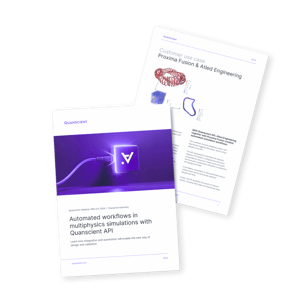What is the Quanscient API?
Quanscient Allsolve, a cloud-based multiphysics simulation software, enables confident design decisions and faster design cycles with the ability to explore more design options taking into account real-world conditions and manufacturing constraints.
The Quanscient API enables automation and integration of simulations within design workflows, reducing manual effort, accelerating design cycles, and allowing for more thorough exploration of design options.
The API supports a wide range of functionalities, from simple parameter sweeps to complex optimization algorithms and inverse problem solving.
Local hardware dependencies, inflexible licensing, and limited interfacing hinder the efficiency of multiphysics simulation workflows
The Quanscient API offers a modern, scalable, and cost-effective approach to multiphysics simulation
The Quanscient API utilizes the same underlying structure as the graphical user interface, facilitating a seamless transition between interactive and programmatic simulation control.
This HTTP-based API provides comprehensive control over projects and simulations, and its OpenAPI definition enables client generation in various programming languages.
For enhanced usability and convenience, a Python SDK package offers a collection of classes and methods tailored to the public API.
Using the Quanscient API, you can run hundreds of simulations easily and concurrently, without preparing any hardware or worrying about handling any infrastructure setup.
Users can readily specify the desired computational resources within their scripts, enabling efficient parallel execution of hundreds of simulations.
The Quanscient API integrates with existing simulation workflows, reducing the need for extensive customization or specialized scripting.
Its structure and functionality allow incorporation into established processes, enabling the use of cloud-based multiphysics with minimal disruption.
The Quanscient API enables various simulation workflows, including AI training and automation
The Quanscient API allows engineers to develop custom Finite Element Analysis (FEA) plugins, integrating simulation directly into existing CAD or PCB design software for streamlined design and rapid iteration.
The Quanscient API enables advanced users with programmatic control over simulations, enabling complex parameter sweeps, custom optimization algorithms, and user-defined formulations.
The Quanscient API allows for the creation of automated simulation pipelines, enabling efficient testing and validation of design iterations without manual intervention.
The Quanscient API enables the generation of comprehensive datasets for training AI models, such as Neural Operators, facilitating rapid and accurate predictions.
The Quanscient API facilitates integration with Simulation Data Management (SDM) systems, automating the storage and management of simulation results and design versions for enhanced traceability and collaboration.
Customer use case
Automated simulation workflow in fusion stellarator design
Proxima Fusion, a company developing stellarator-based fusion reactors, uses the Quanscient API to streamline the design and analysis of their superconducting coils.
Two critical challenges in their work are:
- Quench events: Preparing for quench events, where the superconductor loses its superconductivity, is crucial. Uncontrolled quenches can lead to burned coils or even explosions.
- Mechanical stress: Analyzing the mechanical stress the strong magnetic fields exert on the coil structure is equally important.
Because numerous coil design variations must be considered, Proxima Fusion needed an automated pipeline to perform basic checks after any design changes.
Automated simulation workflow with the Quanscient API
Working with Atled Engineering, Proxima Fusion implemented an automated simulation workflow using the Quanscient API. This workflow consists of several steps:
- Mesh preparation: The process starts with preparing a mesh, including appropriate tagging information. This mesh is then passed to the Quanscient API.
- Resource allocation and preliminary simulation: The API estimates the required degrees of freedom, configures the necessary computational resources (node count and type), and executes a preliminary simulation to determine the background field.
- Full-fidelity analysis: A full-fidelity coil analysis is then performed using a refined mesh and the previously calculated background field.
- Results export: Finally, the API facilitates the export of relevant results, including field maps and mechanical data.
In the end, Proxima Fusion achieved a fully automated coil design and analysis pipeline, enabling them to efficiently explore a wider range of designs, improve coil safety and reliability, and accelerate the development of their fusion reactor.
The current roadmap of API development
- The Quanscient API is currently in a pilot phase with ongoing development based on user feedback.
- The API roadmap is adaptable, allowing us to incorporate user needs and prioritize features accordingly.
- We actively encourage users to provide input and help shape the future of the Quanscient API.
Working on beta version.
More functionality for managing projects, simulations and checking quota.
Better API key management with organization level keys.
Planned first stable public release.
Public repository with the OpenAPI definition and Python SDK.
Meshing capability via the API with coordinate-based picking.
Improved capacity to run large amount of simulations in parallel.
Improved integration to different data stores to reduce moving data around.
Webhooks for receiving simulation status, quota and other events.
Learn more about the API and its applications

Webinar PDF summary
Automated workflows in multiphysics simulations with the Quanscient API
Blog
The future of product design is simulation-driven and automated
Webinar recording
Automated workflows in multiphysics simulations with the Quanscient API

See how it could work for you
Submit the form to talk with our experts—we'll respond within 1 business day. You'll learn:
- How Allsolve could fit your use case
- What results to expect (accuracy, runtime, design exploration capabilities and rough cost range)
- How it could plug into your workflow today
Interested in just seeing an on-demand demo? Watch the 3-minute demo here

